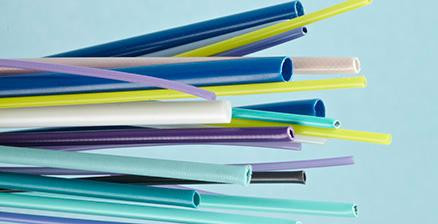PTFE tubes or Teflon Tubes are extensively used with
virtually all industrial solvents, chemicals, and corrosive materials, and can
be used in varied processes at high temperatures. It is steam sterilized without
impacting its physical properties, such as surface hardness, elongation, flex
life or deformation under load. PTFE Tubes are translucent white in color,
however, the whiteness degree varies in the ones which have dimensional wall
thickness. Colored Teflon tubes are also available and generally used for
simplification for tube routing during system installations.
Polytetrafluoroethylene (PTFE) is a
high molecular polymer and is a big part
of the cable and tubing industry because
it has some unique properties starting right from electrical properties to
chemical inertness also high-temperature
resistance. This material is much in demand as
far as manufacturing and
industrial sectors are concerned because it has specific properties.
The Properties of PTFE Tubes
The properties of PTFE tubings are pretty unlike other metal
pipes or carbon pipes.
Thermal properties- PTFE has heat-resistant properties and this enables this kind
of pipes to withstand high temperatures of 680 °F for a certain period
of time under cryogenic conditions; PTFE tubes do not change their properties
even when they undergo extreme high
temperatures such as 500 degrees Fahrenheit and it is cold temperatures almost down to -320 °F.
UV resistance and wearability- PTFE
tubes have other qualities such as UV resistance and wearability quality.
Wear and Friction – PTFE has its
smooth surface and it has excellent wear and frictional qualities.
Electrical properties- PTFE tubing
also has insulation properties, in other words,
it is a great insulator and it’s and surface resistivity is pretty
great.
Advanced Fluro Tubes is a much-recognized PTFE Tube
manufacturer and supplier. They manufacture reliable
and quality PTFE tubes that start
from 0.8mm to 28 mm ID and 0.25mm to 3.5 mm wall thickness.
PTFE tubes are considered flexible tubes and they are
manufactured in several continuous lengths ranging from 300-20 meters. When it
comes to continuous lengths we emphasize two things the OD & ID of the
PTFE tube. Advanced Fluro tubes have other products
such as long length PTFE rods or ropes that have a diameter from2mm-8mm. These PTFE ropes help in the sealing of applications.
As PTFE tube
manufacturers of pretty sound repute,
they ensure that they carry out proper
quality checks and ensure that they carry out
extremely tight tolerances which besides
preventing leakage also reduce scrap.
As a leading PTFE
tube manufacturer and supplier, the manufacturers ensure that they deliver
pipes and tubes right on schedule making their
customers satisfied and happy.
Some application properties increase
the abrasion resistance of
self-lubricating PTFE tubes. Here engineers
emphasize the application and
serve customized solutions the application requirements.
For example, there are numerous applications that require
PTFE tubes with antistatic properties.
Besides, virgin PTFE tubes advanced fluoro tubes also manufacture numerous services for example such as
end flaring, sleeving, and specific cut lengths and so on.






